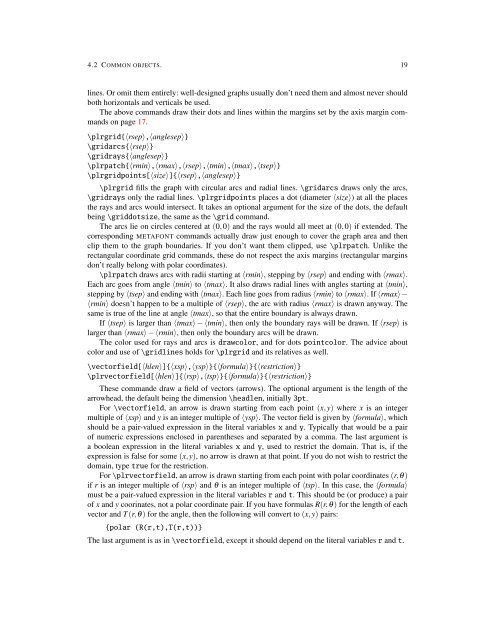You also want an ePaper? Increase the reach of your titles
YUMPU automatically turns print PDFs into web optimized ePapers that Google loves.
4.2 COMMON OBJECTS. 19<br />
lines. Or omit them entirely: well-designed graphs usually don’t need them and almost never should<br />
both horizontals and verticals be used.<br />
The above commands draw their dots and lines within the margins set by the axis margin commands<br />
on page 17.<br />
\plrgrid{〈rsep〉,〈anglesep〉}<br />
\gridarcs{〈rsep〉}<br />
\gridrays{〈anglesep〉}<br />
\plrpatch{〈rmin〉,〈rmax〉,〈rsep〉,〈tmin〉,〈tmax〉,〈tsep〉}<br />
\plrgridpoints[〈size〉]{〈rsep〉,〈anglesep〉}<br />
\plrgrid fills the graph with circular arcs and radial lines. \gridarcs draws only the arcs,<br />
\gridrays only the radial lines. \plrgridpoints places a dot (diameter 〈size〉) at all the places<br />
the rays and arcs would intersect. It takes an optional argument for the size of the dots, the default<br />
being \griddotsize, the same as the \grid command.<br />
The arcs lie on circles centered at (0,0) and the rays would all meet at (0,0) if extended. The<br />
corresponding METAFONT commands actually draw just enough to cover the graph area and then<br />
clip them to the graph boundaries. If you don’t want them clipped, use \plrpatch. Unlike the<br />
rectangular coordinate grid commands, these do not respect the axis margins (rectangular margins<br />
don’t really belong with polar coordinates).<br />
\plrpatch draws arcs with radii starting at 〈rmin〉, stepping by 〈rsep〉 and ending with 〈rmax〉.<br />
Each arc goes from angle 〈tmin〉 to 〈tmax〉. It also draws radial lines with angles starting at 〈tmin〉,<br />
stepping by 〈tsep〉 and ending with 〈tmax〉. Each line goes from radius 〈rmin〉 to 〈rmax〉. If 〈rmax〉−<br />
〈rmin〉 doesn’t happen to be a multiple of 〈rsep〉, the arc with radius 〈rmax〉 is drawn anyway. The<br />
same is true of the line at angle 〈tmax〉, so that the entire boundary is always drawn.<br />
If 〈tsep〉 is larger than 〈tmax〉 − 〈tmin〉, then only the boundary rays will be drawn. If 〈rsep〉 is<br />
larger than 〈rmax〉 − 〈rmin〉, then only the boundary arcs will be drawn.<br />
The color used for rays and arcs is drawcolor, and for dots pointcolor. The advice about<br />
color and use of \gridlines holds for \plrgrid and its relatives as well.<br />
\vectorfield[〈hlen〉]{〈xsp〉,〈ysp〉}{〈formula〉}{〈restriction〉}<br />
\plrvectorfield[〈hlen〉]{〈rsp〉,〈tsp〉}{〈formula〉}{〈restriction〉}<br />
These commande draw a field of vectors (arrows). The optional argument is the length of the<br />
arrowhead, the default being the dimension \headlen, initially 3pt.<br />
For \vectorfield, an arrow is drawn starting from each point (x,y) where x is an integer<br />
multiple of 〈xsp〉 and y is an integer multiple of 〈ysp〉. The vector field is given by 〈formula〉, which<br />
should be a pair-valued expression in the literal variables x and y. Typically that would be a pair<br />
of numeric expressions enclosed in parentheses and separated by a comma. The last argument is<br />
a boolean expression in the literal variables x and y, used to restrict the domain. That is, if the<br />
expression is false for some (x,y), no arrow is drawn at that point. If you do not wish to restrict the<br />
domain, type true for the restriction.<br />
For \plrvectorfield, an arrow is drawn starting from each point with polar coordinates (r,θ)<br />
if r is an integer multiple of 〈rsp〉 and θ is an integer multiple of 〈tsp〉. In this case, the 〈formula〉<br />
must be a pair-valued expression in the literal variables r and t. This should be (or produce) a pair<br />
of x and y coorinates, not a polar coordinate pair. If you have formulas R(r,θ) for the length of each<br />
vector and T (r,θ) for the angle, then the following will convert to (x,y) pairs:<br />
{polar (R(r,t),T(r,t))}<br />
The last argument is as in \vectorfield, except it should depend on the literal variables r and t.

















